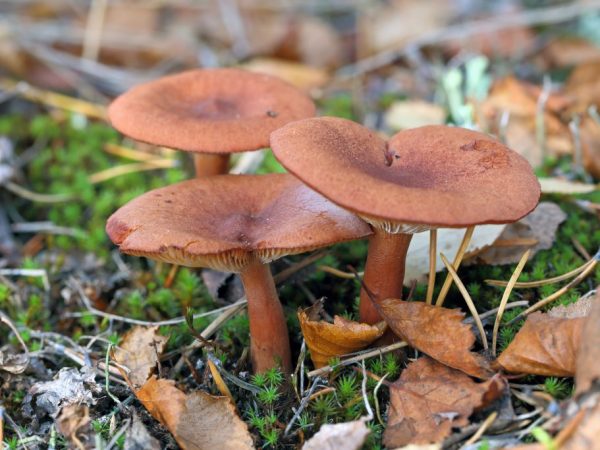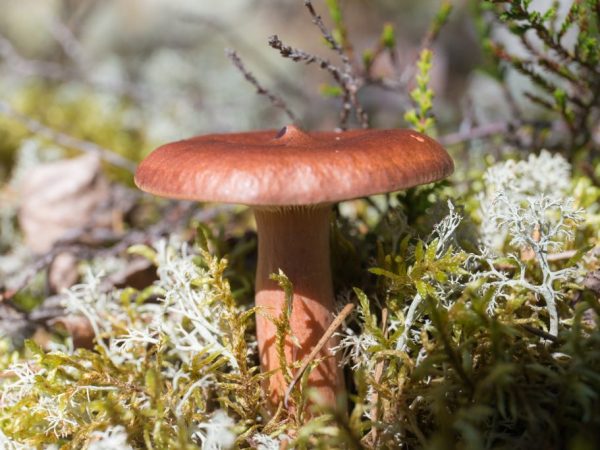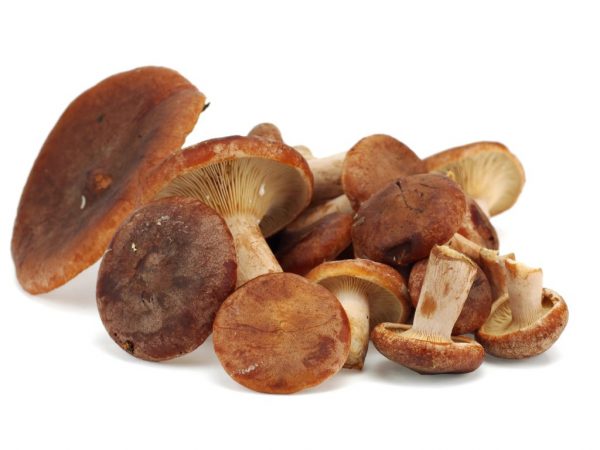Features of the bitter mushroom
The bitter mushroom brings rich harvests every year. It grows abundantly throughout Russia from the first days of summer to late autumn, withstands light frosts on the soil, down to -5 ° C.

Features of the bitter mushroom
Description
Bitter mushrooms (Lactarius rufus), belong to the russula family, genus Mlechnik. Popularly, the species is called bitter milk mushroom or bitter milk mushroom because of its peculiar smell and pungent, burning bitterness.
This mushroom is edible only after processing. It does not have its own bright taste, so it is ranked among the last, 4th flavor category, to conditionally edible mushrooms.
Description of appearance:
- the diameter of the cap is 2.5-9 cm;
- flat-convex shape;
- the skin is brownish red;
- hymenophore plates are frequent and fragile;
- woody aroma;
- growth - up to 10-11 cm;
- leg base thickness - 2 cm;
- the color of the leg is uniform, brown;
- there is a whitish fluff at the base of the leg.
A distinctive feature of bitter is the change in the shape of the cap with age. It turns into an open, inverted funnel with a bulge in the center.
The pulp, even in age fungi, remains creamy and homogeneous. It contains a whitish watery juice, dense, with a gray tint. Bitter is rarely affected by pests. Upon contact with air, the juice does not change its natural (white) color.
The structure of the leg changes with age: in the young it is dense, in the old it is fibrous, sometimes hollow.

Bitter mushrooms (lactarius rufus) belong to the russula family, the genus Lacticella
Twin mushrooms
Gorchak, or bitter, has several doubles, some of which are edible, and some are not. They are cleverly disguised as the original. These include:
- camphor milky;
- marsh lump;
- the milkman is meat-red;
- hepatic lactate.
The hot, scalding juice, which only the original bitter has, is the main distinguishing feature by which it is easy to recognize a real mushroom. This juice never changes its color.
Miller camphor
The camphor lactus (Lactarius camphoratus) belongs to the russula family, characterized by the lamellar structure of the cap's hymenophore. It belongs to the group of conditionally edible mushrooms, this species grows in North America and on the territory of Eurasia in coniferous or mixed forests, where it forms mycorrhiza with representatives of coniferous trees.
Prefers to live on decaying forest floor or wood. Prefers slightly acidic or acidic soils for development.
In Russia, the camphor milky is found throughout the European part and in the Far East. Its description:
- pleasant to the touch matte surface of the cap;
- the surface is red-brown;
- loose pulp;
- wide plates of the hymenophore are located close to each other;
- the color of the plates is red with dark spots;
- a leg in the form of a cylinder;
- the structure of the leg is fragile;
- leg length - up to 5-8 cm;
- aroma medicinal, camphor;
- the taste is insipid;
- the juice is white, does not change color upon contact with air.
False mountain goats bear fruit for about 3 months, from July to early October. They are classified in the low, 4 flavor category: these are conditionally edible mushrooms. They require pre-processing, so they are usually used for salting or boiled.
Swamp bush
Swamp milk mushroom (Lactarius sphagneti) is an edible species of the Russula family, belongs to the lamellar mushrooms. It is lamellar and brittle. Grows in clusters, on moist soils, in lowlands, from June to November. Its description:
- the body is dense, with a red skin of the cap;
- cap diameter - up to 5 cm;
- the shape of the cap is in the form of a funnel with a tubercle in the center;
- plates are frequent, descending to the leg;
- plates can be intertwined and form peculiar patterns;
- the color of the plates is reddish;
- the base of the leg with fibers, dense and fluffy;
- the pulp is creamy in color;
- the taste is unpleasant, sharp;
- the whitish milky sap interacts with oxygen and, being oxidized, changes color to gray with a yellow tint.
Old mushrooms are hollow inside.
The color of marsh mushrooms depends on the climate, soil and place of growth. The condition of the soil affects the taste and size of organisms. Prefers humid places, does not like heat. Found in all types of forests in Eurasia.
The marsh mushroom belongs to the group of edible mushrooms.
Liver Miller
Liver miller (Lactarius hepaticus) is not eaten because of the pungent taste and therefore it is classified as an inedible mushroom.
The cap is small, can reach a maximum diameter of 6 cm. The color resembles the color of a fresh liver, which is where the specific name comes from. There is a recess in the center of the cap, so they say that the cap is funnel-shaped. The leg is thin, cylindrical, up to 1 cm in diameter. The color of the leg matches the color of the cap. White milky juice turns yellow in air.
The flesh inside is usually creamy or beige.
More often the variety is found in pine forests, where it forms mycorrhiza with woody species. It grows best on acidic sandy soils.

The bitter mushroom has several counterparts.
Miller meat-red
Meat-red miller (Lactarius trivialis) is sometimes also called smooth, alder, smooth or iron. It belongs to conditionally edible mushrooms from the russula family. The species is characterized by the following description:
- large surface of the cap (up to 20 cm);
- a fold to the leg is noticeable from the edge;
- the center has a depression;
- the color can range from lilac to brown-pink;
- hymenophore type - lamellar;
- thin beige plates;
- the leg is cylindrical;
- the structure of the pulp is tender, brittle and light;
- weak aroma;
- the taste is pungent.
The change in the color of the liquid that stands out on the cut from white to yellowish is a feature of this species. Mycorrhiza with birch, pine or spruce is a natural state for this fungus. Fruiting begins in July, and continues until the last days of October on the fertile coniferous soils of Asia or Europe.
Useful and harmful properties
Bitter contains many substances useful for the human body. The younger the forest organism, the more of them. Mushrooms contain a large number of amino acids: tyrosine, glutamine, arginine, etc. Fatty acids are also referred to useful substances: palmitic, stearic, butyric. The pulp also contains acetic acid.
Swamp mushroom contains a lot of phosphatides and essential oils. Carbohydrates, sugar alcohols, fiber and glycogen are found in all species related to Lactarius rufus.
The presence of arsenic determines the toxicity of some types of bitters.
Application
The chemical composition of the species is different, so each of them has found its own niche for use. Some are used more for the preparation of gourmet dishes, and some are used in medicine, in pharmaceuticals or for cosmetic purposes.
Medicinal use
Some species are used to create medications that help stabilize blood pressure and reduce blood sugar and "bad" cholesterol levels.
The chemical composition of the bitter milk is characterized by an increased content:
The chemical composition of the bitter milk is characterized by an increased content:
- carbohydrates;
- proteins;
- fiber;
- vitamins (especially C and PP);
- microelements (phosphorus, potassium, sodium, magnesium, calcium).
Irina Selyutina (Biologist):
A substance with antibiotic properties was found in the pulp of a bitter mushroom, or red bitter, which, as studies have shown, negatively affects bacteria, including Staphylococcus aureus. This bacterium can cause a wide range of diseases, from mild skin diseases (eg acne, impetigo) to deadly ones (eg meningitis, endocarditis, sepsis). Up to the present day, Staphylococcus aureus is one of the most common causes of emerging nosocomial infections. In addition, it often provokes postoperative wound infections.
You can also talk about the following medicinal properties of bitter:
- normalization of heart rate and blood pressure;
- stimulation of metabolism and hematopoiesis;
- reducing the risk of the onset and development of cancer and infectious diseases;
- antioxidant, anti-inflammatory effect;
- immunostimulation.

The mushroom is used both in medicine and in cooking.
Cooking applications
The fruiting bodies of bitterness are tender and fragile. To keep them better, they are laid out in one layer in the shade and in a cool place. This condition is very important, because in direct sunlight they will oxidize and disappear. Cooking is started no later than 4 hours after collection.
Irina Selyutina (Biologist):
When collecting bitters, you should adhere to the following points:
- the least bitter taste, which means that the best gastronomic qualities are inherent in young mushrooms;
- the surface of the caps must have a uniform color;
- the cap must be free of external damage and defects.
Preliminary primary treatment is required to release toxins, an unpleasant aftertaste of milky juice. The mushrooms are washed several times, it is better to do this in running water. After that, it is soaked for 3-8 hours.
The smoothie is excellent for salting: this treatment makes it possible to quickly go through the fermentation process. Before salting, they are soaked for 3 to 5 days with regular daily water changes. Then they are poured over with boiling water and filled with brine. Both hot and cold salting methods are used.
The meatiness of this species is appreciated by gourmets. It is sometimes used for frying, after which the dish turns out to be spicy, with a peculiar pungent taste, although cooking takes place without the addition of hot spices.
But even after the most careful and correct processing, the bitter is used practically only in salted and pickled form. You can serve the bitter milk as a separate dish, as well as including it in salads and cold appetizers from vegetables, poultry and meat.
Conclusion
The high yield of bitters allows you to collect it in large quantities and enjoy tasty preparations throughout the long winter months. With proper preparation and compliance with the conditions of collection and storage, it is easy to please friends with interesting and exotic dishes.



